Movie Reviews
Saturday Night at the Toons
The Jungle Book
This movie’s chief claim to fame is that it was the last one produced by Walt Disney. There are those who speculate that if it had been a financial failure the studio might have ceased producing animated features altogether. To me, it is a second step in the decline of Disney animation that began with The Sword in the Stone and continued through the ‘70s and ‘80s, a long period of growing mediocrity that would not be reversed until Jeffrey Katzenberg took over the animated features division and started producing a string of masterpieces beginning with The Little Mermaid in 1989. Like Sword, there is nothing particularly bad about it, but it lacks heart, is badly paced, and its hero fails to generate much interest. (It also marks the beginning of a period when I felt too grown up to see Disney animated films. This lasted until The Black Cauldron, another disappointment.) And finally, it was released at a time when much more adventurous, much hipper films—R-rated or even X-rated—were being produced by the likes of Ralph Bakshi with Fritz the Cat and Heavy Traffic. Disney films seemed hopelessly lame compared to that.
The good news is, parts of it are excellent. The background art is sensational. The film is another step toward using celebrities as voices, a trend I have railed against, but the “names” here are not superstars like Mel Gibson or Meryl Streep. Phil Harris is Baloo the bear, Louis Prima is King Louie the orangutan (which don’t inhabit India, but never mind; he’s exceptionally well drawn and animated), Sebastian Cabot is Bagheera the black panther, Sterling Holloway is very good as Kaa, the snake (python? boa?), and George Sanders is absolutely brilliant as Shere Khan the tiger. Against these talents, Mowgli the wolf-boy, or man-cub, practically vanishes. Two of the songs, “The Bare Necessities” and “I Wan’na Be Like You” are catchy and cute and jazzy. Shere Khan is a triumph of menace, but my favorite character is Kaa, who is brilliantly animated, with coils of him appearing here and there and everywhere. He must be 100 feet long. There is also a quartet of vultures. One of them speaks with an accent that is distinctly Liverpudlian, and has a (rather disheveled) Beatles mop-top haircut. So later I learn that the Beatles’ manager, George Martin, was arranging for the Fab Four to actually voice the vultures, but John Lennon wasn’t into it. That surprised me. It seems like just the sort of thing he would have gone for.
There were the usual complaints about violating the source material. For once I’ve actually read some Kipling fables … but it was the wrong fables. I had a copy of Just So Stories when I was young. I remember “The Elephant’s Child,” which told of how the elephant got his trunk. The story is that Disney handed the book to the chief animator and said, “The first thing I want you to do is not read it.” So the darker elements have been expunged, “Disneyfied,” and several characters are changed. Shere Khan is not killed, merely driven away by fire. Kaa was a friend to Mowgli in the book; in the film he spends all his time trying to eat him.
For once I don’t have to issue a PC warning about smoking. Nobody smokes here. But I do have to give a stupidity warning. There were some who objected to King Louie as an offensive racial stereotype. What the …? They’re saying he was supposed to be a Negro? But he’s not black, he’s orange. He’s a monkey, for chrissake (actually, an ape). Did these idiots think he was speaking black dialect? That’s bullshit. He was speaking jazz, jive, hepcat, and that’s spoken by both blacks and whites, from Duke Ellington to Lord Buckley. He was voiced by Louis Prima, an Italian. I think those critics were revealing their own racism by seeing a jive-talking monkey, eating bananas and living in the jungle and immediately thinking … Jungle equals Negro! Racism! Fuck ‘em.
Reality check: These observations are offered in the spirit of fun. I know an animated cartoon needn’t stick to logic or reality in any form. But … Mowgli, raised by wolves, never having come into contact with humans, at the age of about ten seems to have figured out for himself how to make a pair of shorts. And sees the need to wear them. There are the usual predator/prey issues; Bagheera would certainly have eaten the abandoned infant rather than take him to the wolves … who also would have eaten him, the Romulus and Remus legend notwithstanding. A little more seriously, at the very end Mowgli comes to the man village and sees a young woman drawing water in a jug. He’s dazzled. She’s flirty … and also has a little red dot on her forehead that, I believe, indicates she is of the Brahmin caste. Mowgli, as a casteless foundling, raised by wolves … what would he be? By default I expect he’d be an untouchable. Which would put the girl sadly out of bounds. Forever. Oh, well, back to the jungle, maybe he’ll have better luck with the monkeys …
